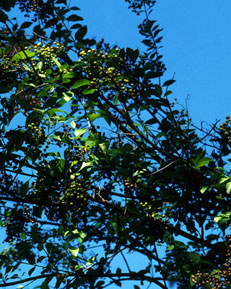
Photo © Steven Foster
Introduction
Henna, native to Africa and Asia, has been used for close to 3 millennia.1 The perennial shrub can grow to 10 feet and is distinguished by its pale bark and white or light pink aromatic flowers. The useful part of the plant is the dried leaf.1 Henna is broadly cultivated in tropical areas such as Egypt, Sudan, China, India, Florida, and the West Indies.2 History and Cultural Significance
Henna was first referenced in the Bible, but it was the ancient Egyptians who were renowned for making great use of this herb.3 In Egypt and India as well as other Arabic countries, henna was most notably used to dye hair, nails, and other body parts such as the hands and soles of the feet. The plant was also used to dye fabric and horses’ tails. The essential oil from the leaves and flowers has been long used as a perfume in both Egyptian and Indian cultures.3 Historically, henna leaves were used externally to help treat skin problems, headaches, and inflammation.4 In Asian folk medicine, topical uses included the treatment of dandruff, eczema, scabies, fungus, and ulcers.4 Henna flowers were also employed externally as an astringent for the skin as well as to combat excessive perspiration.3 Historically, henna was taken orally to induce urination and to treat stomach ulcers.4 Henna is dried or powdered and sorted into three varieties: green, black, and neutral.5 In developed countries, henna is used almost exclusively for hair dye and conditioner and less frequently in cosmetics. Modern Research
Current laboratory research suggests that compounds in henna leaves may possess antioxidant properties.6,7 However, there are currently no human clinical studies on the internal or external uses of henna. Future Outlook
The main growers and exporters of henna are Egypt, India, Iran, Morocco, Pakistan, Sudan, and Yemen.8 Much of what is grown stays in country for domestic use. For example, Pakistan exports no more than half of the 15,000 metric tons it grows each year. However, the demand for henna in the US and the UK is increasing and growers are increasing production to meet this demand. Pakistan, for one, is increasing its henna production to 18,000 metric tons per year.8 References
1 Bruneton J, ed. Pharmacognosy, Phytochemistry, Medicinal Plants. 2nd ed. Paris: Lavoisier; 1999. 2 Leung AY, Foster S, eds. Encyclopedia of Common Natural Ingredients Used in Food, Drugs, and Cosmetics. 2nd ed. New York: John Wiley and Sons, Inc; 1996. 3 Duke JA. Herbs of the Bible. Longmont, CO: Interweave Press; 2000. 4 Jellin JM, ed. Natural Medicines Comprehensive Database. Stockton, CA: Therapeutic Research Faculty; 2002. 5 Wichtl M, Brinckman J. Herbal Drugs and Phytopharmaceuticals. Stuttgart: Medpharm GmbH Scientific Publishers; 2004. 6 Mikhaeil BR, Badria FA, Maatooq GT, Amer MM. Antioxidant and immunomodulatory constituents of henna leaves. Z Naturforsch. July-August 2004;59(7-8):468-476. 7 Endrini S, Rahmat A, Ismail P, Yun Hin T. Anticarcinogenic Properties and Antioxidant Activity of Henna (Lawsonia inermis). J Med Sci. July-August 2002;2:194-197. Available at: http://www.ansinet.org/fulltext/jms/jms24194-197.pdf. 8 Henna – Production and Trade. Plant Cultures: Exploring Plants and People. Updated November 18, 2004. Available at: http://www.plantcultures.org.uk/plants/henna_production__trade.html. Accessed May 30, 2005.
|